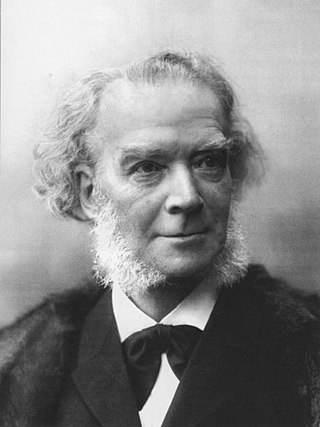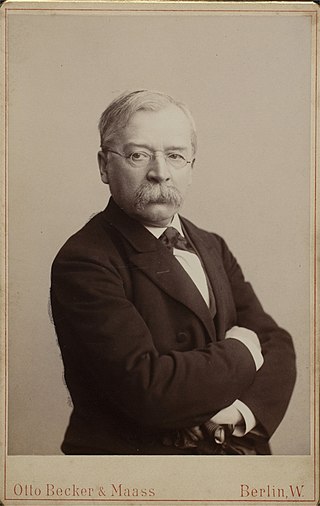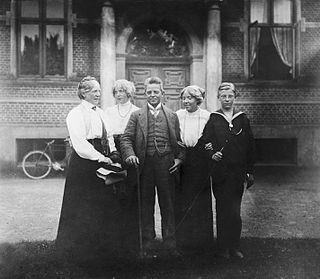Related Research Articles
Robert Wilfred Levick Simpson was an English composer, as well as a long-serving BBC producer and broadcaster.

A string orchestra is an orchestra consisting solely of a string section made up of the bowed strings used in Western Classical music. The instruments of such an orchestra are most often the following: the violin, which is divided into first and second violin players, the viola, the cello, and usually, but not always, the double bass.

Hugo Emil Alfvén was a Swedish composer, conductor, violinist, and painter.
Cyclic form is a technique of musical construction, involving multiple sections or movements, in which a theme, melody, or thematic material occurs in more than one movement as a unifying device. Sometimes a theme may occur at the beginning and end ; other times a theme occurs in a different guise in every part.

Carl Heinrich Carsten Reinecke was a German composer, conductor, and pianist in the mid-Romantic era.

Woldemar Bargiel was a German composer and conductor of the Romantic period.
Antonín Dvořák composed the String Quartet No. 13 in G major, Op. 106, between November 11 and December 9, 1895. It was first performed by the Bohemian Quartet in Prague on October 9, 1896.

The String Octet in E-flat major, Op. 20, MWV R 20, was written by the 16-year-old Felix Mendelssohn during the fall of 1825 and completed on October 15. Written for four violins, two violas, and two cellos, this work created a new chamber music genre. Conrad Wilson summarizes much of its reception ever since: "Its youthful verve, brilliance and perfection make it one of the miracles of nineteenth-century music." This was one of the first works of Mendelssohn to be very well received.
The Op. 33 String Quartets were written by Joseph Haydn in the summer and Autumn of 1781 for the Viennese publisher Artaria. This set of string quartets has several nicknames, the most common of which is the "Russian" quartets, because Haydn dedicated the quartets to the Grand Duke Paul of Russia and many of the quartets were premiered on Christmas Day, 1781, at the Viennese apartment of the Duke's wife, the Grand Duchess Maria Feodorovna. Some scholars theorize that the "Russian" quartets were the inspiration for Mozart's six string quartets dedicated to Haydn, but no direct evidence has been found.
Pyotr Ilyich Tchaikovsky composed his Orchestral Suite No. 3 in G, Op. 55 in 1884, writing it concurrently with his Concert Fantasia in G, Op. 56, for piano and orchestra. The originally intended opening movement of the suite, Contrastes, instead became the closing movement of the fantasia. Both works were also intended initially as more mainstream compositions than they became; the fantasia was intended as a piano concerto, while the suite was conceived as a symphony.

The Piano Quartet No. 1 in G minor, Op. 25, was composed by Johannes Brahms between 1856 and 1861. It was premiered in 1861 in Hamburg, with Clara Schumann at the piano. It was also played in Vienna on 16 November 1862, with Brahms himself at the piano supported by members of the Hellmesberger Quartet. Like most piano quartets, it is scored for piano, violin, viola, and cello.

Carl Nielsen's Suite for String Orchestra was one of the composer's earliest works and was first performed at the Tivoli Hall on 8 September 1888.

Carl Nielsen's String Quartet No. 4 in F major or Quartet for Two Violins, Viola and Cello in F major, Opus 44, was composed between February and July 1906. The last of Nielsen's four string quartets in the official series, its first public performance took place on 30 November 1907 in Copenhagen.
Carl Nielsen's String Quartet No. 3 in E-flat major or Quartet for Two Violins, Viola and Cello in E-flat major, Opus 14, was composed in 1897 and 1898. The third of Nielsen's four string quartets in the official series, it was first performed privately in Vor Forening on 1 May 1899 with Anton Svendsen, Ludvig Holm, Frederik Marke and Ejler Jensen as performers.
Carl Nielsen's String Quartet No. 2 in F minor or Quartet for Two Violins, Viola and Cello in F minor, Opus 5, was composed in 1890, partly in Denmark but mostly in Germany where the composer was travelling on a stipend. The second of Nielsen's four string quartets in the official series, it was first performed privately for Joseph Joachim on 18 November 1890 at the Hochschule für Ausübende Tonkunst in Berlin.

The three String Trios, Op. 9 were composed by Ludwig van Beethoven in 1797–98. He published them in Vienna in 1799, with a dedication to his patron Count Johann Georg von Browne (1767–1827). They were first performed by the violinist Ignaz Schuppanzigh with two colleagues from his string quartet. According to the violinist and conductor Angus Watson, these were probably Franz Weiss on viola and either Nikolaus Kraft or his father Anton on cello. Each of the trios consists of four movements:
References
- ↑ "Love and Marriage", Carl Nielsen Society. Retrieved 27 October 2010.
- ↑ "Symphonic Suite Opus 8", Piano Works, Carl Nielsen Edition Archived 2010-04-09 at the Wayback Machine , Royal Danish Library. Retrieved 27 October 2010.
- ↑ "Nielsen: String Quartets Volume 1", Chandos Records Ltd, 1998.
- ↑ It seems more likely to have been published in 1902, despite the dedication. Consider http://anno.onb.ac.at/cgi-content/anno-buch?apm=0&aid=1000001&bd=0001902&teil=0203&seite=00000107&zoom=2.
- ↑ Keith Anderson, "Nielsen, C. String Quartets, Vol 2", Classics Online. Retrieved 27 October 2010.
- ↑ "Performances" Archived 2011-07-24 at the Wayback Machine , Carl Nielsen Society. Retrieved 30 October 2010.